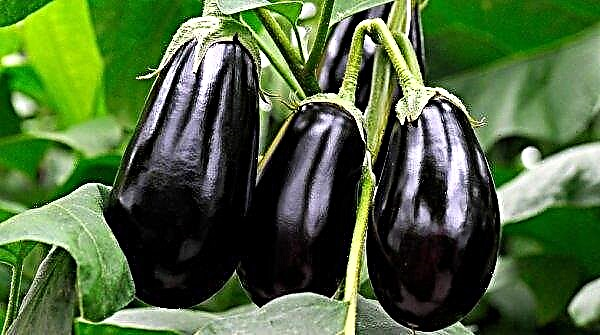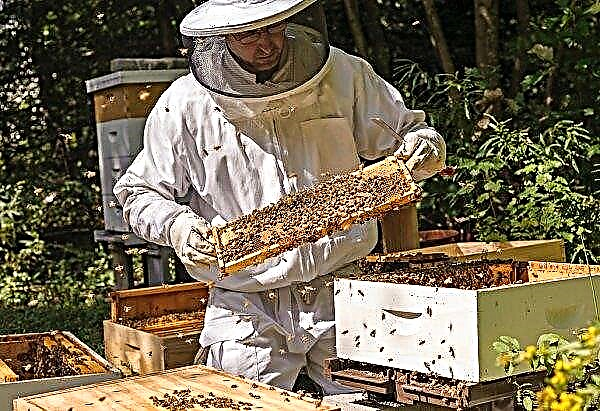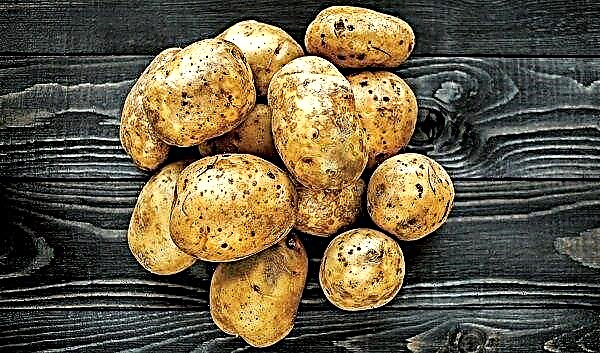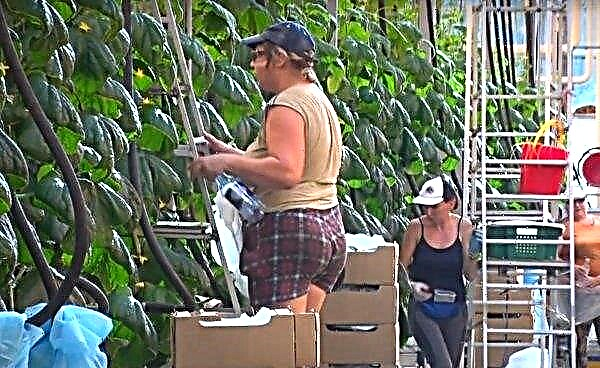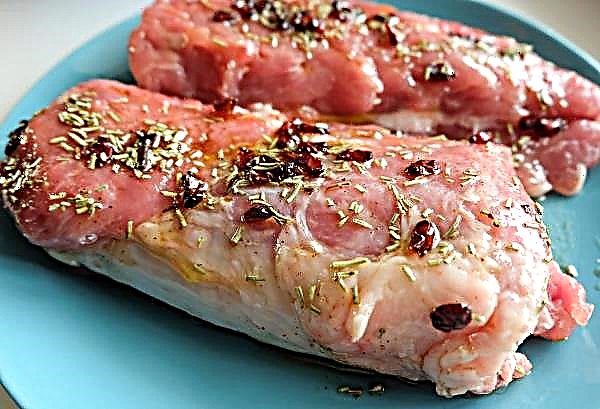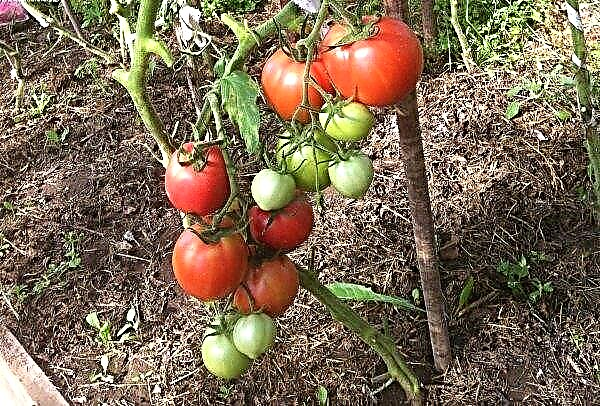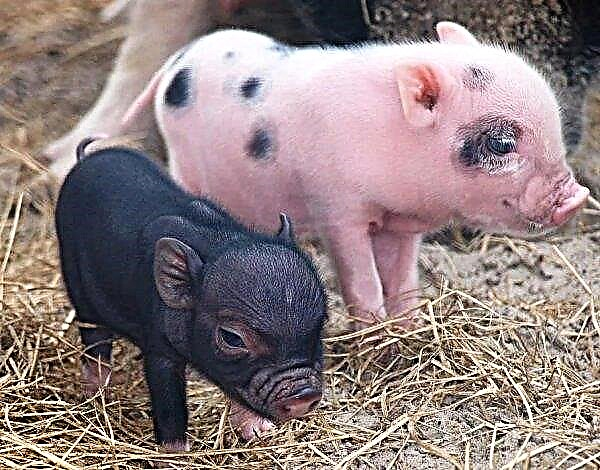The first association that comes to mind when mentioning a tomato is the red color of its fruits. However, not all varieties have a "traditional" color and can sometimes surprise. The representative of the "multi-colored" is the "Black Moor", whose color becomes apparent from the name.
Grade description
The official year of birth of the variety is considered the 2000th, when it was entered in the register of crops. The breeders who bred Black Moor are a group of scientists led by Vladimir Nalizhitiy.
"Black Moor", despite the name, is not completely black - it recognizes the red color, although it is very dark.Did you know? An interesting name - wolf peaches - was given to tomatoes by the Swedish naturalist Karl Linnaeus, who lived in the XVIII century.
In addition to color, it has several distinctive properties:
- refers to medium-term varieties, ripening on average 120 days after emergence;
- the variety is characterized by semi-determinism, in height it can reach 1.5 m;
- strongly growing shoots, and therefore requires pinching;
- the bush grows large with a 15-centimeter distance between clusters;
- the leaves have a dark green color and belong to the potato type;
- the first flower grows at least 8, and sometimes 9, leaves, then - every 3 leaves;
- fruits have a plum-like shape;
- the mass of one fruit is 50 g;
- each bush gives an average of 10 fruits, the most fruitful - up to 18;
- their color is dark red, closer to burgundy or even black;
- the peel is thick and does not crack;
- the pulp is characterized by juiciness and sweetness;
- Demonstrates resistance to temperature fluctuations, but not to diseases;
- collection from one bush is up to 5 kg.

Advantages and disadvantages
- The advantages of this variety include:
- very good taste;
- the small size of the fruit makes them very compact;
- thick peel provides protection against damage;
- the possibility of long-term storage of fruits.
- The main disadvantage of the variety is:
- relative to other varieties, susceptibility to diseases and pests.
Self-growing seedlings
An important step in the beginning of the summer cycle are the activities related to seedlings. Proper implementation will ensure plant growth and protection against diseases.
Sowing dates
The most optimal time to start working with seedlings is March. In the first week, work on the preparation of seeds begins, so that by the middle of the month they are placed in the ground.
Important! In the greenhouse, seedlings grow faster, and therefore greenhouse planting is carried out in early April.
Seedlings are moved to a permanent place in late April - early May, depending on when the frost ends.
The soil
Soil for seedlings can be taken from the garden or purchased in a store. Alternatively, do-it-yourself soil making. For this, turf, peat and sand are mixed in equal proportions.
Capacity for growing
Initially, seedlings are planted in boxes with earth and covered with a film in order to retain heat in it. After the first leaves break through, it becomes necessary to provide each plant with sufficient space for growth.

In this regard, a pick is made and each plant receives a separate pot or plastic cup. Both before and after the dive, soil collected in the garden and created by one's own hands can be used.
Seed preparation
The procedure is no different from preparing seeds of other varieties. Seeds ripen for 2 weeks in a well-lit place, after which they are placed in a jar for 3 days.
Then they are washed with potassium permanganate water and all seeds that pop up are removed as unsuitable. After that, they are placed in "Ecosil" or "Epin-extra" for feeding and sown in the ground.
Semi-determinant tomatoes also include the following varieties:
Sowing seeds
Sowing occurs according to the 30 × 40 pattern. When placing seeds in the soil, the depth of the pit is no more than 2 cm - otherwise the roots may get frostbite.
Seedling Care
The temperature regime provides +20 ° C and above, up to +25 ° C. Watering is carried out as the earth dries. They should be positioned in such a way that the plants do not fall under direct sunlight, but at the same time the duration of daylight was at least 8 hours. Top dressing should be done once a month during watering.
Seedling hardening
Hardening is carried out 7 days before landing at a permanent place. When quenching containers with plants for several hours in the afternoon are taken out into the street, and in the evening they are again brought into the house.
Planting seedlings in a permanent place
This event is held at the age of 60 days, but not earlier than the end of spring frost. Tomatoes are placed according to the 65 × 45 pattern, with a distance of 10 cm between the bushes in the same row and 13 cm between the rows themselves. On 1 m² there should be no more than 4 bushes.
Important! When replanting during the first watering, top dressing is mandatory so that the tomato can take root faster and better in a new place.
Outdoor Care
At this stage, plant care activities are similar, but still have their own nuances.
Watering
Since the "Black Moor" is afraid of dampness, watering it is not more than 1 time in 7 days. It is not required to water the leaves, but the stem at the base, so that the roots are saturated with water.
Top dressing
Top dressing is done twice. The first time, as indicated above, is the transplant of plants to a permanent place, and the second - at the beginning of fruiting.
Stepson
Pasynkovanie this variety is required due to the rather violent growth of shoots. There is no unanimous opinion on how to produce pinching: some gardeners offer to leave one stalk, while others prefer two stems. Nevertheless, they agree that the side stepsons are cut very shortly and as they appear.
Soil care
To this end, the earth is regularly loosened to make it easier for the roots to access water from irrigation and air. In addition, weeds are regularly weeded, as they prevent the tomato from growing normally.
Did you know? The biological "relatives" of tomato are tobacco and potatoes.
Mulching is also carried out, mainly to retain moisture in the water and maintain the temperature balance.
Bush tying
Due to the high height of the bush, he needs a timely garter. It is carried out as the tomato grows. In the case of the Black Moor, not only the stem, but also brushes with many fruits are to be tied, otherwise they will break the plant.

Preventative treatment
The main threats to the "Black Moor" are fungus and dampness, so it is extremely important not to allow surpluses when watering. In addition, for prevention are suitable:
- Bordeaux liquid;
- "Confidor" (struggling with whiteflies);
- "Karbofos" (combats spider mites);
- "Barrier" (increases resistance to various negative influences).
The "Black Moor" cannot boast of titanic dimensions or high resistance to disease. Nevertheless, its amazing taste and original appearance is unlikely to leave anyone indifferent, and its high resistance to temperatures significantly expands the halo in which it can be cultivated.


